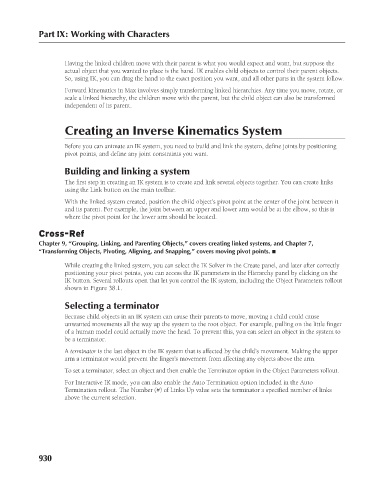Page 978 - Kitab3DsMax
P. 978
Part IX: Working with Characters
Having the linked children move with their parent is what you would expect and want, but suppose the
actual object that you wanted to place is the hand. IK enables child objects to control their parent objects.
So, using IK, you can drag the hand to the exact position you want, and all other parts in the system follow.
Forward kinematics in Max involves simply transforming linked hierarchies. Any time you move, rotate, or
scale a linked hierarchy, the children move with the parent, but the child object can also be transformed
independent of its parent.
Creating an Inverse Kinematics System
Before you can animate an IK system, you need to build and link the system, define joints by positioning
pivot points, and define any joint constraints you want.
Building and linking a system
The first step in creating an IK system is to create and link several objects together. You can create links
using the Link button on the main toolbar.
With the linked system created, position the child object’s pivot point at the center of the joint between it
and its parent. For example, the joint between an upper and lower arm would be at the elbow, so this is
where the pivot point for the lower arm should be located.
Cross-Ref
Chapter 9, “Grouping, Linking, and Parenting Objects,” covers creating linked systems, and Chapter 7,
“Transforming Objects, Pivoting, Aligning, and Snapping,” covers moving pivot points. n
While creating the linked system, you can select the IK Solver in the Create panel, and later after correctly
positioning your pivot points, you can access the IK parameters in the Hierarchy panel by clicking on the
IK button. Several rollouts open that let you control the IK system, including the Object Parameters rollout
shown in Figure 38.1.
Selecting a terminator
Because child objects in an IK system can cause their parents to move, moving a child could cause
unwanted movements all the way up the system to the root object. For example, pulling on the little finger
of a human model could actually move the head. To prevent this, you can select an object in the system to
be a terminator.
A terminator is the last object in the IK system that is affected by the child’s movement. Making the upper
arm a terminator would prevent the finger’s movement from affecting any objects above the arm.
To set a terminator, select an object and then enable the Terminator option in the Object Parameters rollout.
For Interactive IK mode, you can also enable the Auto Termination option included in the Auto
Termination rollout. The Number (#) of Links Up value sets the terminator a specified number of links
above the current selection.
930

